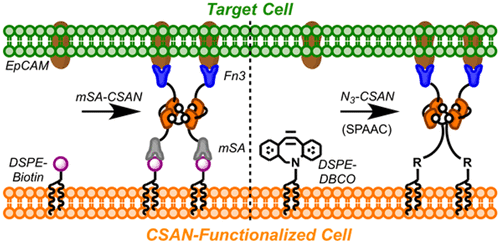当前位置:
X-MOL 学术
›
Bioconjugate Chem.
›
论文详情
Our official English website, www.x-mol.net, welcomes your feedback! (Note: you will need to create a separate account there.)
Engineering Reversible Cell–Cell Interactions with Lipid Anchored Prosthetic Receptors
Bioconjugate Chemistry ( IF 4.7 ) Pub Date : 2018-03-14 00:00:00 , DOI: 10.1021/acs.bioconjchem.8b00058 Clifford M. Csizmar , Jacob R. Petersburg , Alex Hendricks , Lawrence A. Stern , Benjamin J. Hackel , Carston R. Wagner
Bioconjugate Chemistry ( IF 4.7 ) Pub Date : 2018-03-14 00:00:00 , DOI: 10.1021/acs.bioconjchem.8b00058 Clifford M. Csizmar , Jacob R. Petersburg , Alex Hendricks , Lawrence A. Stern , Benjamin J. Hackel , Carston R. Wagner

|
Membrane-engineered cells displaying antigen-targeting ligands are useful as both scientific tools and clinical therapeutics. While genetically encoded artificial receptors have proven efficacious, their scope remains limited, as this approach is not amenable to all cell types and the modification is often permanent. Our group has developed a nongenetic method to rapidly, stably, and reversibly modify any cell membrane with a chemically self-assembled nanoring (CSAN) that can function as a prosthetic receptor. Bifunctional CSANs displaying epithelial cell adhesion molecule (EpCAM)-targeted fibronectin domains were installed on the cell membrane through hydrophobic insertion and remained stably bound for ≥72 h in vitro. These CSAN-labeled cells were capable of recognizing EpCAM-expressing target cells, forming intercellular interactions that were subsequently reversed by disassembling the nanoring with the FDA-approved antibiotic, trimethoprim. This study demonstrates the use of this system to engineer cell surfaces with prosthetic receptors capable of directing specific and reversible cell–cell interactions.
中文翻译:

工程与脂质锚定的修复受体的可逆细胞间相互作用。
显示抗原靶向配体的膜工程细胞可用作科学工具和临床治疗剂。尽管已经证明了遗传编码的人工受体是有效的,但是它们的范围仍然有限,因为这种方法不适用于所有细胞类型,并且修饰通常是永久性的。我们的小组已经开发出一种非遗传方法,可以利用化学自组装的纳米环(CSAN)快速,稳定和可逆地修饰任何细胞膜,而后者可以充当人工受体。通过疏水性插入将显示上皮细胞粘附分子(EpCAM)靶向纤连蛋白结构域的双功能CSAN安装在细胞膜上,并在体外≥72h稳定结合。这些CSAN标记的细胞能够识别表达EpCAM的靶细胞,形成细胞间相互作用,随后通过用FDA批准的抗生素甲氧苄啶分解纳米环而逆转。这项研究表明,该系统可用于利用能够指导特异性和可逆细胞间相互作用的修复受体改造细胞表面。
更新日期:2018-03-14
中文翻译:

工程与脂质锚定的修复受体的可逆细胞间相互作用。
显示抗原靶向配体的膜工程细胞可用作科学工具和临床治疗剂。尽管已经证明了遗传编码的人工受体是有效的,但是它们的范围仍然有限,因为这种方法不适用于所有细胞类型,并且修饰通常是永久性的。我们的小组已经开发出一种非遗传方法,可以利用化学自组装的纳米环(CSAN)快速,稳定和可逆地修饰任何细胞膜,而后者可以充当人工受体。通过疏水性插入将显示上皮细胞粘附分子(EpCAM)靶向纤连蛋白结构域的双功能CSAN安装在细胞膜上,并在体外≥72h稳定结合。这些CSAN标记的细胞能够识别表达EpCAM的靶细胞,形成细胞间相互作用,随后通过用FDA批准的抗生素甲氧苄啶分解纳米环而逆转。这项研究表明,该系统可用于利用能够指导特异性和可逆细胞间相互作用的修复受体改造细胞表面。



























 京公网安备 11010802027423号
京公网安备 11010802027423号